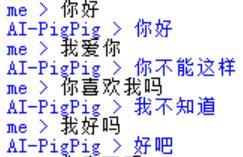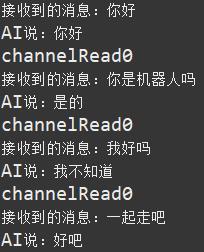集成Netty|tensorflow实现 聊天AI--PigPig养成记(2)
集成Netty
项目github链接
通过上一节的学习我们已经可以训练得到一只傲娇的聊天AI_PigPig了。

本章将介绍项目关于Netty的集成问题,将其我们的AI_PigPig可以通过web应用与大家日常互撩。
由于只是一个小测试,所以不考虑性能方面的问题,在下一章我们将重点处理效率难关,集成Redis。
关于Netty的学习大家可以看我的另一篇文章,本节中关于Netty部分的代码改编自该文章中的 netty聊天小练习 ,文章中会有详细的讲解。
Python代码改动
首先对测试训练结果的代码进行改动,将输入输出流重定向自作为中间媒介的测试文件中。
完整代码链接
with tf.Session() as sess:#打开作为一次会话
# 恢复前一次训练
ckpt = tf.train.get_checkpoint_state('.')#从检查点文件中返回一个状态(ckpt)
#如果ckpt存在,输出模型路径
if ckpt != None:
print(ckpt.model_checkpoint_path)
model.saver.restore(sess, ckpt.model_checkpoint_path)#储存模型参数
else:
print("没找到模型")
#测试该模型的能力
while True:
#从文件中进行读取
#input_string = input('me > ')
#测试文件输入格式为"[内容]:[名字]"
#eg.你好:AI【表示AI的回复】
#你好:user【表示用户的输入】
with open('./temp.txt','r+',encoding='ANSI') as myf:
#从文件中读取用户的输入
line=myf.read()
list1=line.split(':')
#长度为一,表明不符合输入格式,设置为"no",则不进行测试处理
if len(list1)==1:
input_string='no'
else:
#符合输入格式,证明是用户输入的
#input_string为用户输入的内容
input_string=list1[0]
myf.seek(0)
#清空文件
myf.truncate()
#写入"no",若读到"no",则不进行测试处理
myf.write('no')
# 退出
if input_string == 'quit':
exit()
#若读到"no",则不进行测试处理
if input_string != 'no':
input_string_vec = []#输入字符串向量化
for words in input_string.strip():
input_string_vec.append(vocab_en.get(words, UNK_ID))#get()函数:如果words在词表中,返回索引号;否则,返回UNK_ID
bucket_id = min([b for b in range(len(buckets)) if buckets[b][0] > len(input_string_vec)])#保留最小的大于输入的bucket的id
encoder_inputs, decoder_inputs, target_weights = model.get_batch({bucket_id: [(input_string_vec, [])]}, bucket_id)
#get_batch(A,B):两个参数,A为大小为len(buckets)的元组,返回了指定bucket_id的encoder_inputs,decoder_inputs,target_weights
_, _, output_logits = model.step(sess, encoder_inputs, decoder_inputs, target_weights, bucket_id, True)
#得到其输出
outputs = [int(np.argmax(logit, axis=1)) for logit in output_logits]#求得最大的预测范围列表
if EOS_ID in outputs:#如果EOS_ID在输出内部,则输出列表为[,,,,:End]
outputs = outputs[:outputs.index(EOS_ID)]
response = "".join([tf.compat.as_str(vocab_de[output]) for output in outputs])#转为解码词汇分别添加到回复中
print('AI-PigPig > ' + response)#输出回复
#将AI的回复以要求的格式进行写入,方便Netty程序读取
with open('./temp1.txt','w',encoding='ANSI') as myf1:
myf1.write(response+':AI')
Netty程序
完整代码参见 链接 netty包下。
在原本的ChatHandler类中添加了从文件中读取数据的方法readFromFile,以及向文件中覆盖地写入数据的方法writeToFile。
//从文件中读取数据
private static String readFromFile(String filePath) {
File file=new File(filePath);
String line=null;
String name=null;
String content=null;
try {
//以content:name的形式写入
BufferedReader br=new BufferedReader(new FileReader(file));
line=br.readLine();
String [] arr=line.split(":");
if(arr.length==1) {
name=null;
content=null;
}else {
content=arr[0];
name=arr[1];
}
br.close();
} catch (FileNotFoundException e) {
e.printStackTrace();
} catch (IOException e) {
e.printStackTrace();
}
return content;
}
//向文件中覆盖地写入
private static void writeToFile(String filePath,String content) {
File file =new File(filePath);
try {
FileWriter fileWriter=new FileWriter(file);
fileWriter.write("");
fileWriter.flush();
fileWriter.write(content);
fileWriter.close();
} catch (IOException e) {
e.printStackTrace();
}
}
对原来的channelRead0方法进行修改,将输入输出流重定向到临时文件中。
@Override
protected void channelRead0(ChannelHandlerContext ctx, TextWebSocketFrame msg) throws Exception {
System.out.println("channelRead0");
//得到用户输入的消息,需要写入文件/缓存中,让AI进行读取
String content=msg.text();
if(content==null||content=="") {
System.out.println("content 为null");
return ;
}
System.out.println("接收到的消息:"+content);
//写入
writeToFile(writeFilePath, content+":user");
//给AI回复与写入的时间,后期会增对性能方面进行改进
Thread.sleep(1000);
//读取AI返回的内容
String AIsay=readFromFile(readFilePath);
//读取后马上写入
writeToFile(readFilePath,"no");
//没有说,或者还没说
if(AIsay==null||AIsay==""||AIsay=="no") {
System.out.println("AIsay为空或no");
return;
}
System.out.println("AI说:"+AIsay);
clients.writeAndFlush(
new TextWebSocketFrame(
"AI_PigPig在"+LocalDateTime.now()
+"说:"+AIsay));
}
客户端代码
<!DOCTYPE html>
<html>
<head>
<meta charset="utf-8" />
<title></title>
</head>
<body>
<div>发送消息:</div>
<input type="text" id="msgContent"/>
<input type="button" value="点我发送" onclick="CHAT.chat()"/>
<div>接受消息:</div>
<div id="receiveMsg" style="background-color: gainsboro;"></div>
<script type="application/javascript">
window.CHAT = {
socket: null,
init: function() {
if (window.WebSocket) {
CHAT.socket = new WebSocket("ws://192.168.0.104:8088/ws");
CHAT.socket.onopen = function() {
console.log("连接建立成功...");
},
CHAT.socket.onclose = function() {
console.log("连接关闭...");
},
CHAT.socket.onerror = function() {
console.log("发生错误...");
},
CHAT.socket.onmessage = function(e) {
console.log("接受到消息:" + e.data);
var receiveMsg = document.getElementById("receiveMsg");
var html = receiveMsg.innerHTML;
receiveMsg.innerHTML = html + "<br/>" + e.data;
}
} else {
alert("浏览器不支持websocket协议...");
}
},
chat: function() {
var msg = document.getElementById("msgContent");
CHAT.socket.send(msg.value);
}
};
CHAT.init();
</script>
</body>
</html>
测试结果
客户端发送消息

用户与AI日常互撩

正文到此结束
热门推荐
相关文章
Loading...











![[HBLOG]公众号](https://www.liuhaihua.cn/img/qrcode_gzh.jpg)

